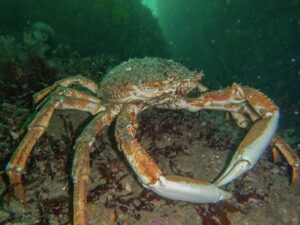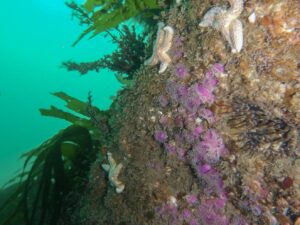Black Head
is the headland inside the Old Head of Kinsale. It has become one of our divers favourite dive sites and for good reason. Diving Black Head is an easy dive and can be a fantastic introduction to diving in Ireland. Let me tell you all about it.

Depth
This is not a deep site and can be dived and enjoyed by both novice and experienced divers. The maximum depth is around 15M depending on the tide, but it can feel like a much deeper dive at times because of the narrow passage ways. Suitable for PADI Open Water divers
Topography
The site is a mixture of rocky reef and sandy gullies. there are lots of gullies to explore and you will encounter loads of marine life on each. Some of the gullies are narrow and have steep sides which give the feeling of a much deeper dive than it actually is.
Scuba Diving the Canyon
You start the dive at the North side of the headland, here you drop into a small gully approximately 6m deep. The walls of the gully are straight up and marine algae cling to the rocks. If you examine the walls closely you will find nudibranchs, skeleton shrimp, painted top shells, periwinkles and dog whelk hiding in the “weed”




Along the bottom of the gully you will swim over some large rocks and some sea weed. You can very often spot Pipe fish here. As you move along the gully there will be plenty of big spider crabs early in the season and indeed throughout the summer as well.
Head in a South Westerly Direction
 Once you start to head in a general south westerly direction you will pass through a narrow “entrance” leading to narrow passage ways and wider bowls. At this point you will see some hydroids on your left hand side that are usually crawling with skeleton shrimp.
Once you start to head in a general south westerly direction you will pass through a narrow “entrance” leading to narrow passage ways and wider bowls. At this point you will see some hydroids on your left hand side that are usually crawling with skeleton shrimp.
The first little bowl has cracks on the left that are home to some brown crab, velvet crab and shrimp. You may also see Tompot Blennies and Red Blennies here too . The wall on the right is covered with sponges and anemones and it is worth taking time to have a good look among them for some nudibranchs, once you see the first one you will see plenty.
Great Biodiversity on this dive
 You now go through another narrow gap into a large bowl area. This is a great space to explore. The walls are covered with interesting marine life including jewel and dahlia anemones, dead man’s fingers, hydroids and more. The floor had large “flattish” boulders and there is often dead sea weed on the floor. It is a great hang out for scorpion fish, spider crab and the weed normally has plenty of nudis and other tiny critters on it.
You now go through another narrow gap into a large bowl area. This is a great space to explore. The walls are covered with interesting marine life including jewel and dahlia anemones, dead man’s fingers, hydroids and more. The floor had large “flattish” boulders and there is often dead sea weed on the floor. It is a great hang out for scorpion fish, spider crab and the weed normally has plenty of nudis and other tiny critters on it.
Heading through the next narrow gap the diver passes through a long narrow “canyon”. Again check out the walls, Oaten pipes hydroids stand 10 to 15 cm straight out from the walls. In spring you will often see nudibranch feeding on their pink flower like conical shaped polyps. Splashes of purple and yellow are supplied by beautiful jewel anemones.
 Their bigger cousins the Dahlia anemones are here too in brilliant shades of red, pink, purple and orange. Planted between the anemones are unassuming hydroids, home to colonies of skeleton shrimp. This is a site where you need to travel very slowly and get your eye in for the little guys of the ocean.
Their bigger cousins the Dahlia anemones are here too in brilliant shades of red, pink, purple and orange. Planted between the anemones are unassuming hydroids, home to colonies of skeleton shrimp. This is a site where you need to travel very slowly and get your eye in for the little guys of the ocean.
When you get past this narrow passage the area opens again There is some kelp anchored to the rocks you will often see lobsters here in the rocky reef beside neighbouring conger eels. Plenty of shrimp and leopard spotted gobies peep from the rocks and sometimes if you are lucky you will to see a crayfish out for a walk.
On sandy floors dragonets, painted gobies and sand gobies dart in all directions and sometimes here too, if you are lucky, you can spot an angler fish, a common skate or thornback ray resting in the sand. Small red and pink scorpion fish hide under seaweed.
Lots of Gullies to Explore
From here you can explore some of the other gullies before continuing South West. The gully gets very narrow and at the “end’ of it you can “hop” to the South and if you hit is just right you will end up in another bowl area. The walls of this area are really beautifully coloured as they are covered in jewel anemones in many colours – pink, purple, yellow, orange, brown, green. It is just incredible.
Go South for the boat pick up
Now you head South to make for an easy boat pickup. Hanging at your 5m safety stop tiny hydroid jellies and some bigger jellyfish often float by in the summer time.
Conclusion
At this point I think you will agree that the Canyon, Black Head is super dive. There are many side alleys and narrow gullies to explore with interest around every rock. It is a wonderful site for underwater photographers. Because of its relatively shallow depth and there is plenty of time to explore and perfect your image.
You will want to come back.












